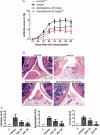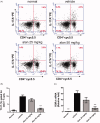Alantolactone alleviates collagen-induced arthritis and inhibits Th17 cell differentiation through modulation of STAT3 signalling
- PMID: 33556301
- PMCID: PMC8871681
- DOI: 10.1080/13880209.2021.1876102
Alantolactone alleviates collagen-induced arthritis and inhibits Th17 cell differentiation through modulation of STAT3 signalling
Abstract
Context: Alantolactone, the bioactive component in Inula helenium L. (Asteraceae), exhibits multiple biological effects.
Objective: We aimed to determine the anti-inflammatory effect of alantolactone in a collagen-induced arthritis (CIA) mouse model and its immunomodulatory effects on Th17 differentiation.
Materials and methods: A CIA mouse model was established with DBA/1 mice randomly divided into four groups (n = 6): healthy, vehicle and two alantolactone-treated groups (25 or 50 mg/kg), followed by oral administration of alantolactone to mice for 21 consecutive days after arthritis onset. The severity of CIA was evaluated by an arthritic scoring system and histopathological examination. Levels of cytokines and anti-CII antibodies as well as percentages of splenic Th17 and Th17 differentiation with or without alantolactone treatments (0.62, 1.2 or 2.5 μM) were detected with ELISA and flow cytometry, respectively. Western blot analysis was used to evaluate intracellular signalling in alantolactone-treated spleen cells.
Results: In CIA mice, alantolactone at 50 mg/kg attenuated RA symptoms, including high arthritis scores, infiltrating inflammatory cells, synovial hyperplasia, bone erosion and levels of the proinflammatory cytokines TNF-α, IL-6 and IL-17A, but not IL-10 in paw tissues. Alantolactone also reduced the number of splenic Th17 cells and the capability of naïve CD4+ T cells to differentiate into the Th17 subset by downregulating STAT3/RORγt signalling by as early as 24 h of treatment.
Discussion and conclusions: Alantolactone possesses an anti-inflammatory effect that suppresses murine CIA by inhibiting Th17 cell differentiation, suggesting alantolactone is an adjunctive therapeutic candidate to treat rheumatoid arthritis.
Keywords: Inula helenium L.; IL-17A; IL-6; RORγt; anti-inflammation; bone erosion; synovial hyperplasia.
Conflict of interest statement
No potential conflict of interest was reported by the author(s).
Figures








References
-
- Aithal GP. 2011. Hepatotoxicity related to antirheumatic drugs. Nat Rev Rheumatol. 7(3):139–150. - PubMed
-
- Bettelli E, Carrier Y, Gao W, Korn T, Strom TB, Oukka M, Weiner HL, Kuchroo VK.. 2006. Reciprocal developmental pathways for the generation of pathogenic effector Th17 and regulatory T cells. Nature. 441(7090):235–238. - PubMed
-
- Brand DD, Latham KA, Rosloniec EF.. 2007. Collagen-induced arthritis. Nat Protoc. 2(5):1269–1275. - PubMed
-
- Cantrell CL, Abate L, Fronczek FR, Franzblau SG, Quijano L, Fischer NH.. 1999. Antimycobacterial eudesmanolides from Inula helenium and Rudbeckia subtomentosa. Planta Med. 65(4):351–355. - PubMed
MeSH terms
Substances
LinkOut - more resources
Full Text Sources
Other Literature Sources
Research Materials
Miscellaneous
